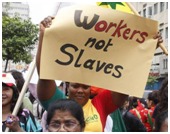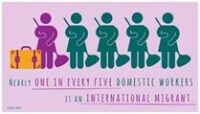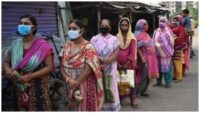* Author: Nupur Pattanaik
As the entire society woke up to the global shutdown and economic collapse following the COVID-19 pandemic, all economic zones have been reeling under its ramifications. This encompasses “the unchecked enterprise” of the domestic workers, which mainly hires and engages women. While women have substantially bestowed to progress of the economy, little has been done to safeguard and preserve the female domestic workers, most of whom are migrants. Migrants employed in the domestic work sector are indispensable to the COVID-19 retaliation, due to the significant role they play in the safekeeping of children, sick, and dependent people, as well as the preservation and perpetuation of homes. Nevertheless, despite their extensive benefaction to the working of households and the economy, they tend to be one of the communities worst affected by the catastrophe. The paper reflects on the plights of migrant domestic workers in times of COVID-19 pandemic as well as post-pandemic concerns.
Conventionally, domestic work has been considered unsteady and unreliable due to impoverished or even conscienceless and torturous working circumstances, such as prolonged working phases, shallow wages, informal circumstances, small scale-to-invisible societal protection, and a propensity to reside with their employers.
Domestic work is a salient and foremost means of livelihood for millions of individuals, accounting for up to 10 per cent of total workforce participation in some countries. The tendency of movement over the past decade has resulted in a heightened ubiquity regarding the magnitude of migrants among domestic workers with an immense mass of these workers being female. Migrant domestic workers are at the risk of increased vulnerability to certain forms of ill-treatment and indecent assaults.

Source: www.reimaginerpe.org
At the peak of their marginalisation is segregation, seclusion and dependency, manifested in different ways, like: being away from near and dear ones, lack of basic necessities, alienation with the language and culture, lack of awareness about national and global labour and migration laws, subservience and subordination to the employer because of migration-related debts or sponsorship systems, ambiguous legal status, employers limiting freedom of movement and withholding passports and other documents, and dependency of families back home on remittances.

Source: www.esem.org.mk
Women migrant domestic workers are subjected to gender-based discrimination and atrocities. These menaces and susceptibilities are exacerbated for migrant domestic workers who are unregistered, not least because they often counter the risk of expulsion or banishment if they approach State authorities to seek defence from inhuman and brutal employers.
Millions of people around the globe are moving, adjusting to life in countries not their own. In some cases, this act is voluntary, as people search for better life chances like education or work. In many more cases, however, the migration is forced, as people flee poverty, war or pandemic, or as they search for employments that will simply allow them to exist. The catastrophe of COVID-19 has challenged the livelihood of these migrant domestic workers. A migrant labourer is an individual espoused in a waged venture in a region in which he or she is not a native. The International Labour Organization (ILO) defines a domestic worker as “a wage-earner working in a privatized family circle, under unofficial procedure and span of settlement, who may be hired by one or by several recruiters who receive no monetary gain from these occupations.” Domestic workers are usually occupied as housekeepers, nannies, cooks, drivers, gardeners, and other personal servants. Some domestic and migrant workers labour under bonded circumstances.
The Precarious Predicaments
60 million domestic workers around the globe provide necessary and vital assistance so others can work outside their homes, keeping markets and economies working globally. A 2018 announcement delivered by UN Women stated that the Caribbean region has high density of unofficial working circumstances among domestic labourers, with 90% of them recruited informally. The countries with high rates of undocumented occupational conditions for domestic workers were also brought to notice: Haiti (99%), Dominican Republic (96.5%), Jamaica (92%) and Guyana (94.9%). According to the estimates of International labour Organisation (ILO), 93% of domestic workers in the Caribbean are female, and out of this, 17% of domestic workers are migrants. Moreover, race and class divides are noticeable in the domestic work sector with Afro descendants and indigenous populations disproportionately represented in domestic labour.

Source: www.ilo.org
Most, though not all, domestic workers are women and the majority are from the downtrodden and marginal section of the social ladder. The impacts of the catastrophic pandemic on the informal sector in India have been witnessed-through the predicaments of the migrant workers, but one group that is often left out of the spotlight,is the domestic workers.
While official statistics reveal that India has 4.75 million domestic workers, out of which 3 million are women, this is considered to be very underrated-the real number could be anywhere between 20 to 80 million workers, as put forward by the ILO. As we can see, more than two-thirds of those working in these occupations are female, with most of them hailing from states such as Jharkhand, West Bengal Assam and Odisha.
During this pandemic, a lot of migrant women employed in domestic work are facing the crisis of joblessness. Many families are either not remunerating their domestic help by paying their full wage, or are letting them out- leaving them jobless. Their trepidation for health, along with diminished employment opportunities due to the shutdown, stress as well as inability to meet their economic needs during the period of closure has affected their social wellbeing as they are pushed to the edges of precariousness.
The unprecedented lockdown measures and emergent economic recession have negatively affected undocumented workers near and far. There are no estimates to determine how many are suffering due to the employment cuts, lockdown and pandemic. Many have been dismissed as the new era of ‘workcation’ has seized on, with their employers leaving towns to work from plantations, resorts and homestays. Most unorganised sector workers are male labourers with wives working as domestic help.
Both have been hit hardest by job losses. Many have taken debts to pursue their children’s education and are struggling hard to pay monthly instalments to micro-finances, which are demanding extra interest due to delayed payments.
Migrant domestic workers often reside in the employer’s home, surviving not only the challenges of live-in domestics but also exploitation within the occupational system and even from police and immigration authorities, which is manifested in various ways like payment of advance commission fees, deducted wages, denial of passports, and verbal, physical, or mental harassment. Severe instancesof violence, such asmurder, have been documented. To protect migrant domestic workers, laws and regulations are essential at the international level and in both sending and receiving countries worldwide.
Gig Economy and Threat to Quality of Life
The Gig economy, which is based on freelance, temporary positions with short term commitments, is more prominent among the people who hire the domestic maids. The entry of domestic work into the gig economy with affordable apps such as ‘Housemaid for you’ and ‘Helpers near me’, which has paved the way for informalisation of the workforce and domestic labour. This new development also suffers from marginalisation and susceptibility to exploitation.
Mostly domestic maid’s work and labour is informal and not documented, leaving the employees helpless, especially in the hour of pandemic like COVID-19. Centre for Women’s Development Studies (2011) divulged the details that substantial amount of work by female migrant worker is microscopic and concealed because most women initially move for marriage and later join the workforce. The female migration is depicted to a great extent as marriage-migration, leading to an assumed, unjustified assessment of their labour contribution to the economy. Census reports (1991, 2001, 2011) classify majority of women domestic workers as wives, whose potency is tethered to their migrant husbands. These results in sidelining of gender abuse or stereotypes that force the women to migrate.
Migrant experience makes women more endangered and vulnerable, specifically women from the minorities. According to a report released by National Crime Records Bureau (NCRB) that the violence against migrant domestic workers in 2010 was 3411 and in 2012, it has jumped up to 3550 and the global pandemic has further aggravated threats to their livelihood and safety.

Source: BBC
The National Domestic Workers’ Movement (NDWM), which is working to eradicate marginalisation and exploitation of women migrants who are moving within India, addresses the oppositions they encounter and try to ensure women are recruited at better places and provide them with safety measures. Around 2.1 million domestic workers in the Middle East are migrants and majority of them are women from Asian and African countries like Sri Lanka, Philippines, Bangladesh, Nepal, Indonesia, Kenya and Ethiopia. The COVID-19 catastrophe has once again provoked discussion around the systematic victimization of the migrant labourers, especially the domestic maids. It calls for addressing the loopholes in the system and the insecurity and vulnerabilities that revolve around the domestic workers.
The Justice Centre Research (2016) depicted that in Hong Kong 66.3 percent of Migrant Domestic Workers (MDWs), when surveyed, revealed strong signs of abuses and forced labour. In the Gulf countries, migration is operated and sustained by the system of kafala. The migrant workers are guided and governed by the recruiters and if they breach the rules and regulations, they are brutally treated, socially abused and often deported. In the era of pandemic, it has been established that there are some recruiters who do not comply withthe health guidelines in times of pandemic, like provision of mask and sanitizers to the workers, which is again a threat to their livelihood and lives.
Addressing the Challenges
Absence and unavailability of a close-knit and connected policy making framework and organizational system has contributed to these circumstances. The reports by ILO (International Labour Organisation) highlighted that labourers who migrate around the globe are more or less the domestic workers who are working to support their families by risking their own wellbeing due to an unavailability of better conditions and opportunities.
Many live-in domestic workers work for long hours due to the captivity-like-conditions brought by lockdown, without remuneration in some cases. The IOM (International Organization for Migration) has issued a set of guidelines for employers and businesses to enhance migrant worker protection during the COVID-19 pandemic, with specific recommendations to identify and address the unique risks and susceptibilities faced by migrant domestic workers. Guidelines includes the acquisition of healthcare and well-being directives at home, the changing of work commutes to reduce the probability of contracting or transmitting COVID-19, and to ensure the commitment of hirers tosecure their domestic workers in the new-fangled era and identification and updating of migration procedures.
As the domestic maids are the backbone of the society and they constitute a part in the migrant process, a rights-based strategy is required to empower them and provide them with better training and capabilities and secure their subsistence. There is an essential need for the government to mark them as the priority and make their migratory movement sheltered and guarded. In times of the widespread crisis of pandemic, they should be safeguarded. Organizational mechanism is required to address the challenges. The COVID-19 crisis has highlighted the vulnerabilities of at-risk groups of the population and the serious consequences for domestic workers in the Caribbean region, among others.
The pandemic has reflected the State’s responsibility to extend social welfare and labour safeguards for all migrant workers, irrespective of their migrant conditionalities. It is important that this catastrophe does not ignore the labour rights of migrant domestic workers. In order to respond to the above crisis, domestic migrant workers should have access to a labour platform through domestic workers unions to voice their oppositions and challenges, educate them about their rights during the COVID-19 crisis, provide resources and information on how to protect themselves and their families along with information on how to access treatment at their workplace. Providing social security measures by assessing the situation, preparing them for the post-pandemic era decisively, and framing constructive retaliation to the COVID- 19 pandemic through indispensable awareness crusades, social and physical distancing, expeditious and accessible reporting are very necessary to address the challenge at hand.
These espoused strategies should equally apply to both formal and informal employees using an all-inclusive and equity perspective as part of a global strategy and blueprint to overcome this global crisis.
References:
1.https://qrius.com/dark-side-of-the-broom/
2. https://www.wiego.org/informal-economy/occupational-groups/domestic-workers
3. https://www.brandeis.edu/projects/fse/slavery/contemporary/essay-domestic-migrant-workers.html
4. https://thewire.in/labour/women-labour-domestic-work
5. https://news.un.org/en/story/2020/08/1069922
6. http://mfasia.orgstepitup/?page_id=37
7. https://www.antislavery.org/what-we-do/past-projects/india-domestic-workers/
9.https://www.rosanjose.iom.int/SITE/en/blog/how-does-covid-19-impact-migrant-domestic-workers
10.https://caribbeanmigration.org/blog/how-does-covid-19-impact-migrant-domestic-workers
12.https://www.deccanherald.com/sites/dh/files/article_images/2020/05/17/file6xkvb8c6xxuxnwqwk10-1587209901.jpg
13.https://www.bbc.com/news/world-asia-india-52529922
14.https://us.boell.org/en/2020/04/30/invisible-coronavirus-makes-systemic-gender-inequalities-and-injustices-visible

Dr. Nupur Pattanaik, Faculty, Department of Sociology, Central University of Odisha, Koraput. Email: nupur.pattanaik@gmail.com
